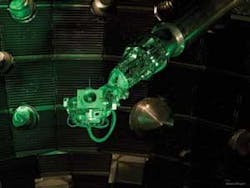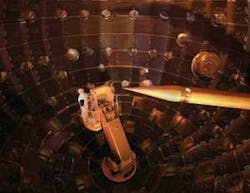PHOTONIC FRONTIERS: THE NATIONAL IGNITION FACILITY: NIF is up and running at last
The National Ignition Facility has been a long time coming. The Department of Energy approved building the giant laser at the Lawrence Livermore National Laboratory (Livermore, CA) in 1994, with construction costs estimated at $900 million and completion scheduled for 2002. But by 1999 the project was in deep technical and management trouble, and its very survival seemed in question.
On March 31 of this year, Energy Secretary Steven Chu formally declared construction complete. Building NIF cost $3.5 billion, nearly four times the original estimate, and lagged nearly seven years behind initial plans. The fully assembled system is now firing test shots, although not delivering the full design energy of 1.8 MJ of ultraviolet light on target. That will come in time as Livermore tests and fine-tunes the laser, slowly nudging its output energy upward. They aren’t shooting to meet a specific date; they’re waiting until they are sure the laser is ready.
That slow and careful approach is a hallmark of Ed Moses, principal associate director of Livermore for NIF and photon science, who has run NIF since 1999. This approach took time, but it got the 192-beam laser up and running after some had thought the project was doomed. It won’t change as NIF approaches full power. Moses views his role as stewardship for a national asset, and his biggest concern is optical damage. “I’m not blowing up my machine,” he says. “The last thing you want is to be a cowboy.” He cites last year’s damage to the Large Hadron Collider at CERN and says that, had he been running their tests, he would have increased power in much smaller steps.
Inertial confinement fusion
The job of NIF is to heat and compress targets containing hydrogen isotopes beyond the threshold for nuclear fusion. The idea of inertial confinement fusion was born at Livermore, where John Nuckolls and colleagues outlined the concept in a 1959 internal memo. Soon after Theodore Maiman built the first laser in 1960, Livermore began firing laser pulses at potential targets.
Laser fusion became a hot idea by the early 1970s, with major U.S. projects at Livermore, the University of Rochester (Rochester, NY), KMS Fusion (Ann Arbor, MI), the Naval Research Laboratory (Washington, DC), and the Los Alamos National Laboratory (Los Alamos, NM). By then fusion work was divided into two distinct but closely related efforts. One was development of fusion reactors for civilian energy production, pursued by KMS and Rochester, and described by Nuckolls, Lowell Wood, and two Livermore colleagues in Nature.1 The second effort was a long-classified program to simulate the heating and compression of hydrogen isotopes in thermonuclear weapons, pursued at Livermore and the other government labs.
The serious money went to the military program, centered at Livermore. Called indirect drive fusion, it uses a two-stage process, with the intense laser pulse first generating a burst of x-rays from a metal foil, and those x-rays then compressing the hydrogen to produce fusion, simulating hydrogen-bomb physics on a smaller scale. During the 1970s, Livermore built increasingly big and powerful neodymium-glass lasers, including Argus, Janus, and Cyclops. The 20-beam, 20 TW Shiva followed at the end of the decade. Livermore’s next step was the 10-beam Nova laser, completed in 1985, which eventually was able to produce 40 kJ, 2.5 ns pulses at 351 nm, delivering 30 kJ to targets.2
However, research at Livermore and elsewhere also revealed unexpected problems. The laser-energy threshold for fusion ignition proved to be much higher than the 10 kJ that Nuckolls had originally calculated. The tests also revealed that target illumination had to be very uniform to avoid troublesome plasma instabilities that could disrupt target compression and fusion. After some debate, Livermore proposed multiplying pulse energy delivered to the target by a factor of 60 to achieve ignition in NIF.
Building NIF
Like Nova, NIF splits a single oscillator pulse among parallel chains of neodymium-glass amplifiers to generate high-energy pulses on the fundamental near-infrared line, and then generates the 351 nm third harmonic. But NIF marks big steps up in energy per beam line, the number of beam lines, and sheer mass and complexity of the system. With 192 beam lines, NIF includes several thousand laser amplifiers and final optics wider than 50 cm (see Fig. 1). The amount of glass is staggering, and the laser is housed in a three-building complex measuring 704 × 403 × 85 ft.
Livermore built and tested a prototype beam line called “Beamlet” to verify its NIF design. Although the Beamlet tests seemed successful, serious problems emerged with capacitors, optical damage, and project management and by 1999 NIF was in trouble. Moses was put in charge with a mandate to get NIF on track.
Optical damage was a key issue. Energy densities reached about one joule per square centimeter on the final optics of both Nova and Rochester’s Omega laser, but NIF’s design called for 8 J/cm2, a big jump. Beamlet exposed a relatively small area to peak energy, so it gave a poor assessment of the risk of damage to NIF, which with 192 beams has 7000 optical components more than 50 cm across, including final optics, lenses, doublers and triplers. “You’re talking about a lot of area” at risk of damage, Moses says.Laser damage is a two-stage process. A high-energy flux initiates the damage, but after the initial event, the damaged zone can grow at a lower energy. “When I got here, we were seeing 100,000 initiators per shot,” Moses says. “We figured out we had to go down five orders of magnitude” to limit damage in NIF. To do that he launched an intense effort that ranged from studying the physics of the damage process to working with vendors on cleanliness and post-processing. To check for damage to surfaces, Livermore added an inspection system that can spot failure initiators as small as 5 µm—it spends 45 minutes after each shot checking the optics (see Fig. 2). If the system detects any weak points, the affected component is swapped out and repaired.
It’s been a big effort, but Moses says, “We think damage is in the bag.” He boasts that NIF is now firing with optics “that seem damage-proof at around 10 J/cm2.”
Ramping up the power
NIF is now in the midst of its National Ignition Campaign, which runs from 2006 to 2012, and aims at demonstrating ignition. Early this year, NIF easily passed the criteria set in 1997 for commissioning—installation of all 192 beams, with 96 of them together generating 500 kJ in the ultraviolet. In March, Livermore brought ultraviolet energy up to 1.1 MJ, just under 60% of the full output energy. It also ran eight beam lines at energies of 9 kJ in the ultraviolet, enough to reach the target 1.8 MJ when all 192 beams are operating. But the cautious Moses plans to continue ramping the power up slowly, not reaching full power until autumn 2010.The system’s modular design and sophisticated control system gives Livermore tremendous control over operation. The beams are grouped in hierarchical structures. Quads of four beams combine to enter a port of the target chamber (see Fig. 3). Two quads make a bundle, one entering the top half of the target chamber, the other entering the bottom. Six 8-beam bundles make a cluster, two clusters make a 96-beam laser bay, and two bays make NIF. Each beam can be managed separately, or grouped with others in its quad, bundle, and so forth.
Two million lines of software manage laser operation. “It shoots itself, to the first order. All the beam lines are autoaligning. We’re trying to get to the point where we’re spectators,” Moses says. With 192 beams in NIF, he thinks that’s a necessity.
In early September, Livermore researchers described their first ignition-campaign experiments at the sixth international Inertial Fusion Science and Applications conference in San Francisco, CA.3 “We fired nine shots at 600 kJ with 192 beams, delivering the right spot size,” in a series of cryogenic target shots spanning two weeks, says Moses. “We are very happy about this.” He’s also happy about shots with targets containing 10% deuterium mixed with 90% helium, which yielded NIF’s first fusion neutrons that Livermore is still analyzing.
Outlook
NIF has come a long way from its low point, and Moses credits the optics and laser industry for playing a big role in the recovery. He says NIF should reach the full 1.8 MJ level in about a year, and fire 250 shots in fiscal 2010, reaching 700 shots a year in 2012. By then he hopes to have demonstrated ignition as well.
Yet success is not guaranteed. Optical damage is a notoriously tough problem and reaching new realms of laser energy has a history of revealing new physics that makes it harder to control laser-plasma interactions. Questions have been raised about how well NIF can perform, how well laser fusion can simulate nuclear detonations, and whether civilian fusion power is within the technological horizon. Within a few years, we should have some of the answers.
Meanwhile, Livermore is eying the next generation of fusion lasers, with a plan called Laser Inertial Fusion Energy (see www.laserfocusworld.com/articles/346691) that would use a diode-pumped solid-state laser firing NIF-energy pulses at repetition rates of 10 to 15 per second at deuterium-tritium fusion targets. 4
ACKNOWLEDGMENT
Credit is given to Lawrence Livermore National Security LLC, Lawrence Livermore National Laboratory, and the Department of Energy under whose auspices this work was performed.
REFERENCES
- J.H. Nuckolls et al., Nature 239, p. 139 (1972).
- T. Perry and B. Remington, Science and Tech. Revi., Sept .1997 (/www.llnl.gov/str/Remington.html)
- https://ifsa09.org/index.php
- Ed Moses, Science and Tech. Rev. Apr/May 2009 (str.llnl.gov/AprMay09/moses.html)
You can find out more about the NIF at the 2010 Lasers & Photonics Marketplace Seminar in January at Photonics West. Dr. Jeff Wisoff, deputy principal associate director of NIF will be the keynote speaker.
About the Author
Jeff Hecht
Contributing Editor
Jeff Hecht is a regular contributing editor to Laser Focus World and has been covering the laser industry for 35 years. A prolific book author, Jeff's published works include “Understanding Fiber Optics,” “Understanding Lasers,” “The Laser Guidebook,” and “Beam Weapons: The Next Arms Race.” He also has written books on the histories of lasers and fiber optics, including “City of Light: The Story of Fiber Optics,” and “Beam: The Race to Make the Laser.” Find out more at jeffhecht.com.



